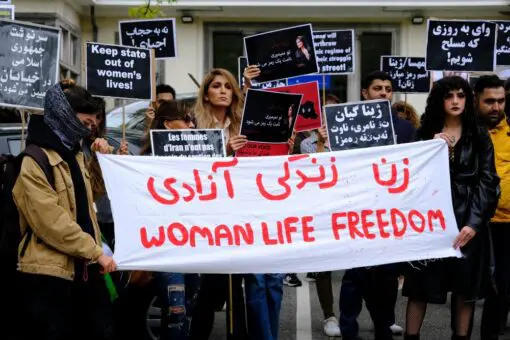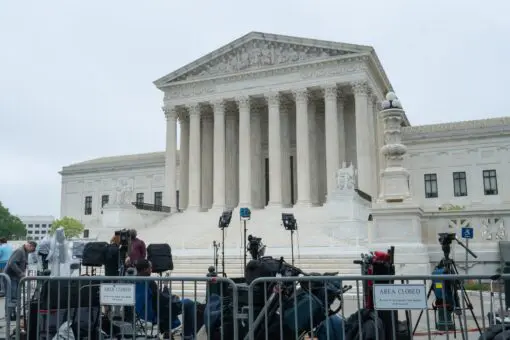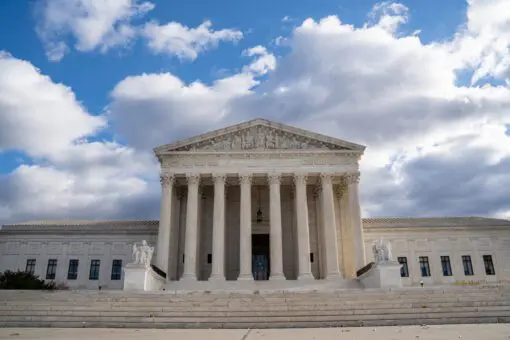Ethics and Abortion
Selected resources from The Hastings Center.
Bioethics Briefings:
Abortion
A central philosophical question in the abortion debate concerns the moral status of the embryo and fetus. Public opinion on abortion falls into three camps—conservative, liberal, and moderate (or gradualist)—each of which draws on both science and ethical thinking. Read our briefing to consider: What are the ethical and legal arguments raised by abortion?
From Hastings Bioethics Forum:
- Cold Comfort for Texas ObstetriciansWhat is a “reasonable medical judgement” that a patient would be harmed before an abortion is permissible?
- Texas Supreme Court Offers Roadmap for Legal AbortionA recent Texas Supreme Court decision with implications for post-Dobbs jurisprudence on abortion seems to have been a victory for those who oppose the practice. It was widely read as upholding Texas’s very strict anti-abortion legislation. I suggest another possible reading of that decision.
- Conscientious Objection and Abortion: Medical Students’ PerspectiveDespite the medical necessity of the abortion, it was delayed and rescheduled twice that day because individual anesthesiologists, technicians, and nurses did not want to be involved in, what several called, “this kind of procedure.”
- A Model of Conscientious Objection to Abortion BansMany clinicians have followed their conscience to find ways to provide good care within the confines of abortion bans. Henry Morgentaler was a model.
- Theocracy Is Closer Than It AppearsOn a cloudy April afternoon, in my home in western Pennsylvania, a headline catches my eye: A federal judge in Texas suspended FDA approval of mifepristone. This abortion-inducing drug has been on the market for more than 20 years. Although the decision is presented with a secular and legal façade, like other recent antiabortion court rulings and legislation, a solid religious motive is at play.
- Requests for Sterilization, Abortion Bans, and Reproductive JusticeIn the nearly three months since the United States Supreme Court’s Dobbs v. Jackson Women’s Health Organization decision eliminated the constitutional right to an abortion, doctors have reported increased…
- Dusting Off Double Effect for the Post-Dobbs EraWhat constitutes a medical emergency for a pregnant patient? ER clinicians in states with abortion bans need to know.
- Abortion Law—Lessons from Medical Aid-in-Dying?Health care and society will strive to find ways to undercut crude bans inconsistent with perceived medical need and professional duty.
- After Roe, What’s Next for End-of-Life Care?The reversal of Roe may be the beginning of an onslaught on our freedoms. I want to add one more worry to the list and point to self-determination at life’s end. Here we have Justice Neil Gorsuch to worry about.
- The End of Roe v. Wade Will Be a Nightmare for Disabled AmericansThe end of federal abortion rights is a disability justice issue—but not in the way you might think.
- Bioethics Without RoeThe Supreme Court decision in Roe v. Wade has played a subtle but critical role in the history of bioethics in America. Would American bioethics discourse be changed with the end of a constitutionally protected right to abortion?
- Leaked Supreme Court Opinion, Structural Sexism, and Our Moral ImaginationThe leaked draft of the Supreme Court’s majority opinion to overturn Roe v. Wade has sent shockwaves throughout the world. Over the last decade, during which we came into…
- Should Pro-Choice Advocates Compromise on Abortion?I’d be happy to go along with a ban on elective abortion after 15 weeks if, but only if, certain conditions accompanied it.
- With Legal Challenges to Abortion, Whither Prenatal Diagnosis?Changes in abortion law threaten to undermine a major benefit of prenatal diagnosis, namely the ability of pregnant women to choose whether or not to continue their pregnancies upon learning of a serious fetal condition.
- Using the Pandemic as an Excuse to Limit AbortionSeveral states, including Ohio, Alabama, Arkansas, Texas, Iowa, and Oklahoma, declared abortion a nonessential service at some point during the pandemic, meaning that it was effectively banned until the crisis passed. Supporters of the policies maintain that abortion is an elective procedure whose medical resources are better off used in the fight against the pandemic. But abortion opponents have been taking advantage of the current circumstances to limit abortion access.
- England’s Abortion Law Catches UpLast month, England announced that it would allow women to take the second pill required for a medical abortion–misoprostol–at home, rather than requiring them to travel to a clinic….
- Preventing Sex-Selective Abortions in America: A Solution in Search of a ProblemArkansas has recently joined seven other states (Arizona, Kansas, North Carolina, North Dakota, Oklahoma, Pennsylvania, and South Dakota) in banning abortions for sex selection. Arizona’s law requires doctors to…
- Reframing Conscientious Care: Q&A with Mara BuchbinderMuch of the conversation about conscience in health care has focused on the ethics of physician refusal to perform procedures that they object to. However, this framework seems insufficient…
- Banning Abortion for Down Syndrome: Legal or Ethical Justification?The Ohio legislature is expected to approve a bill this fall that would make it illegal for doctors to perform an abortion if the reason the woman wants a…
- Ethics, Optics, and Medicine as Work: Backstage at Planned ParenthoodTwo days after a hidden camera video of Planned Parenthood’s senior director of medical services was released, the president of Planned Parenthood Federation of America, Cecile Richards, apologized for…
- Have a Miscarriage and Go to Jail? Potential Consequences of Personhood AmendmentsWhen she was 18, Carmen Guadalupe Vasquez Aldana was sentenced to 30 years in jail. Her crime was delivering a stillborn baby. She was suspected of having had an…
- Arizona’s Ultrasound Mandate, Abortion, and the War on WomenEager to join the ongoing “war on women” and seize the opportunity to roll back women’s reproductive rights, Arizona Republican Governor Jan Brewer signed into law the Women’s Health and…
- Selective ParentingFor years, the abortion of fetuses likely to have disabilities has been called “selective abortion,” but, for reasons made clear in Hilde Lindemann’s thoughtful Bioethics Forumreflection on the matter,…
From Hastings Center Report:
Cruzan after Dobbs: What Remains of the Constitutional Right to Refuse Treatment?
First published: 24 April 2023
Abstract
In 2022, the U.S. Supreme Court removed constitutional protection from the individual’s right to end a pregnancy. In Dobbs v. Jackson Women’s Health Organization, the Court invalidated previous rulings protecting that right as part of the individual liberty and privacy interests embedded in the U.S. Constitution. Now, many observers are speculating about the fate of other rights founded on those interests. The Dobbs ruling conflicts with the Court’s 1990 Cruzan decision restricting the government’s power to interfere with personal medical choices. The language and reasoning in Dobbs and Cruzan offer guidance on how the Court might address future cases involving the right to refuse life-sustaining treatment. The decisions also point to policy strategies for preserving that right.
Legal Discrepancies and Expectations of Women: Abortion, Fetal Therapy, and NICU Care
First published: 24 April 2023
Abstract
Over the past several decades in which access to abortion has become increasingly restricted, parents’ autonomy in medical decision-making in the realms of fetal care and neonatal intensive care has expanded. Today, parents can decide against invasive medical interventions at gestational ages where abortions are forbidden, even in cases where neonates are expected to be seriously ill. Although a declared state interest in protecting the lives of fetuses and newborns contributes to justifications for restricting women’s autonomy with regards to abortion, it does not fully explain this discrepancy. We believe that social portrayals of women as complying with or shirking their reproductive function play a major role in explaining it. The growing divide between a woman’s rights as a reproductive being and as a parent suggest that abortion restriction is rooted in a historical societal desire for women to serve as reproducers and in the corresponding fear of them abandoning this allotted role in pursuit of social equality. The Dobbs v. Jackson (2022) decision is not based in a view of abortion as a medical act occurring between a doctor and patient, as Roe v. Wade (1973) did, but decision-making about fetal therapy or NICU care is still viewed as occurring between a doctor and patient or surrogate because in this act a woman is seen as fulfilling her role as mother.
Louisiana’s “Medically Futile” Unborn Child List: Ethical Lessons at the Post-Dobbs Intersection of Reproductive and Disability Justice
First published: 06 January 2023
Abstract
Ableist attitudes and structures are increasingly recognized across all sectors of health care delivery. After Dobbs, novel questions arose in the United States concerning how to protect reproductive autonomy while avoiding discrimination against and devaluation of disabled persons. In this essay, we examine the Louisiana Department of Health’s emergency declaration, “List of Conditions That Shall Deem an Unborn Child ‘Medically Futile,’” issued August 1, 2022. We raise a number of medical, ethical, and public health concerns that lead us to argue that the declaration should be rescinded. Analysis of this ethically objectionable declaration provides valuable lessons about how to uphold both reproductive and disability justice in a post-Dobbs landscape.
Protecting Health after Dobbs
First published: 20 December 2022
Abstract
In Dobbs v. Jackson Women’s Health Organization, the Supreme Court eliminated the long-standing federal constitutional right to abortion. Discussions of Dobbs tend to emphasize the loss of protection for reproductive choice. But Dobbs also eroded protection for a related yet distinctly important interest that served under Roe v. Wade as a check on government regulation of reproduction: the preservation of health. This erasure has opened the door to increasingly restrictive and punitive abortion bans, which are causing providers to deny or delay care that is necessary to prevent harm to both pregnant and nonpregnant patients. Federal regulatory attempts to prevent these harms will have limited impact, partially due to Congress’s own history of exceptionalizing abortion in ways that devalue health. Only federal legislation can ensure adequate and enduring protection for the health of women, trans men, and other patients targeted for reproductive control because of their capacity for pregnancy.
U.S. Lawsuit Claims Federal Law Can Require Emergency Abortions
First published: 13 October 2022
Abstract
In the wake of the U.S. Supreme Court’s overruling of Roe vs. Wade, states are passing very strict antiabortion laws that the Biden administration is arguing violate the federal Emergency Medical Treatment and Active Labor Act (EMTALA) because those state laws do not permit emergency life-saving abortions that federal law says must be available to patients. The Biden administration has filed suit against Idaho to have portions of its state law invalidated, and Texas has filed suit against the Biden administration, arguing that its interpretation of EMTALA as requiring that abortions be available to patients in some emergency circumstances amounts to an unconstitutional overreach by the federal government. These suits, and others related to them, may redefine health-related federalism in the United States.
Restricting Reasons: A New Battleground in Abortion Regulation
First published: 23 October 2020
Abstract
The latest trend in abortion restrictions in the United States targets a woman’s reasons for terminating a pregnancy. Fourteen states have attempted to enact laws prohibiting abortion on the basis of fetal sex, race, and/or genetic anomaly. These laws are different from regulations tied to a government interest in protecting women’s health. Laws that restrict reasons implicate a different set of government interests to be weighed against a woman’s constitutional right first recognized in Roe v. Wade. These laws also seek to reframe the nature of the right asserted by the woman. To date, the Supreme Court has declined to address the constitutionality of laws that restrict reasons, and the Court’s most recent abortion decisions provide little guidance.
It is possible that a conservative majority of the Supreme Court would uphold a law that prohibits reasons for having an abortion that appear discriminatory. But such laws would be difficult to enforce and therefore may be relegated to policy statements rejecting discriminatory norms as opposed to being effective means of restricting access to abortion.
The Legal Challenge of Abortion Stigma—and Government Restrictions on the Practice of Medicine
First published: 20 April 2020
Abstract
During the 2016 election, Donald Trump won conservative support by promising that he would, if elected, nominate “pro-life” justices to the U.S. Supreme Court. Whether President Trump makes good on his campaign promise to restrict abortion rights may come down to competing impulses of the chief justice, John Roberts. These dueling dispositions—from the man whom many see as the new “swing justice”—hold the key to a blockbuster new case that legal historians call “the most unpredictable the Supreme Court has been on abortion in decades.” The case, June Medical Services v. Russo, turns on arduous new requirements that Louisiana has imposed on facilities and clinicians that provide abortion. But the case is not just about abortion access. The Court will have to decide whether a clinic has a right to challenge the law in the first place.
A Man of Vision: Daniel Callahan on the Nasty Problem and the Noxious Brew
First published: 23 October 2020
Abstract
This essay, published shortly before the 2020 U.S. presidential election (mired in controversy over a potential judicial appointment to the Supreme Court), celebrates Daniel Callahan’s prescient book Abortion: Law, Choice and Morality. Nothing could be timelier. Callahan’s central question was the “moral and social” struggle requisite for coherent policies and laws regulating abortion. He rejected “one-value” positions and strove to develop an expansive middle ground. He decried emotion untutored by reason, crude polemics, and bludgeoning: his recipe for a “noxious brew.” Callahan’s way of thinking preceded the development of a critical health humanities, the advent of moral foundations theory in psychology, and the philosophical concept of a moral imagination. Each of these inheres in his rigorous approach to the abortion problem. His honesty and humility led to a sea change in his position on abortion. Fifty years later, much can still be learned from Callahan’s arguments—about abortion and other bioethics issues—most importantly, in how we address wider social issues in these polarized times.
Rethinking “Elective” Procedures for Women’s Reproduction during Covid-19
First published: 29 June 2020
Abstract
Common hospital and surgical center responses to the Covid-19 pandemic included curtailing “elective” procedures, which are typically determined based on implications for physical health and survival. However, in the focus solely on physical health and survival, procedures whose main benefits advance components of well-being beyond health, including self-determination, personal security, economic stability, equal respect, and creation of meaningful social relationships, have been disproportionately deprioritized. We describe how female reproduction-related procedures, including abortion, surgical sterilization, reversible contraception devices and in vitro fertilization, have been broadly categorized as “elective,” a designation that fails to capture the value of these procedures or their impact on women’s overall well-being. We argue that corresponding restrictions and delays of these procedures are problematically reflective of underlying structural views that marginalize women’s rights and interests and therefore threaten to propagate gender injustice during the pandemic and beyond. Finally, we propose a framework for triaging reproduction-related procedures during Covid-19 that is more individualized, accounts for their significance for comprehensive well-being, and can be used to inform resumption of operations as well as subsequent restriction phases.
Surgeon General’s Warning: Gender Is Bad for Your Health
First published: 08 December 2019
Abstract
Gender, most feminists agree, isn’t a fact about people in the same way that height or hair color is. Genders are constructed within and are part of a power system circulating through all of society that sets standards for men’s and women’s identities and places men’s interests above women’s. The system is bad for all of us, but especially for women, genderqueer people, and men of color. Here, I want to point out ways in which it’s bad for our health. I’ll start with abortion, as laws recently passed in a number of states have restricted women’s access to the point where it’s nearly nonexistent.
Crossing U.S. Borders While Pregnant: An Increasingly Complex Reality
First published: 11 October 2018
Abstract
In response to the Eighth Amendment to the Constitution of Ireland, which states that the fetus and the mother have equal rights to life and that nearly all abortions are therefore illegal, many Irish feminists sported luggage tags that read “HEALTHCARE NOT AIRFARE.” The expression—which recently became a popular twitter hashtag for pro-choice citizens of Ireland leading up to the historic referendum to repeal that abortion ban—refers to the fact that pregnant women from Ireland have long been forced to travel to other European countries in order to legally terminate their pregnancies. In the United States, there is also a deep and challenging relationship between borders and reproductive health. However, that relationship is not understood as clearly as it appears to be in the Irish context. We urgently need to pay careful attention to the interconnections between U.S. border politics and reproductive health care access and to take concrete steps to address resultant injustices.
Defining Life and Regulating Reproductive Choice
First published: 11 October 2018
Abstract
If you blinked you may have missed it. The Department of Health and Human Services published its strategic plan for the 2018–2022 fiscal years, which includes the statement that HHS accomplishes its mission through programs and initiatives that serve and protect “Americans at every stage of life, from conception.” Of note, the “from conception” language is new and, depending on the direction President Trump’s administration plans to go, could have profound implications for the regulation of reproductive services ranging from abortion to in vitro fertilization (IVF).
On Talking Together about Ordinary Abortion
First published: 16 August 2018
Abstract
The scarlet “A” that the protagonist of Nathaniel Hawthorne’s seventeenth-century novel is forced to pin to her dress symbolizes the shame and social disgrace that she endures for conceiving a child out of adultery. In Scarlet A: The Ethics, Law, & Politics of Ordinary Abortion, Katie Watson argues that abortion is our era’s scarlet letter: a mark of stigma that is invisible yet no less shameful, causing unnecessary cultural silences around what is a remarkably common practice. In this brilliant new book, Watson draws on legal proceedings, bioethics literature, and personal experience; offers cultural and literary analysis; and uses her unique vantage point as a lawyer, bioethicist, and medical educator to develop a thought-provoking and thoroughly fresh perspective on one of the most divisive moral issues of our time.
Eugenics Redux: “Reproductive Benefit” as a Rationale for Newborn Screening
First published: 14 August 2018
Abstract
In recent years, as newborn screening has expanded to include conditions for which treatment is questionable, new rationales for screening have proliferated. One such rationale is the potential reproductive benefit to parents from the detection of a genetic condition or carrier status in infants. An unanticipated consequence of invoking knowledge of reproductive risk as a major benefit of screening has been to open newborn screening to the charge that it constitutes state-sanctioned eugenics. Thus, an endeavor that had been viewed as the converse of state programs of selective breeding has come to be seen in some quarters as yet another of its incarnations. The result has been serious and self-inflected harm to the reputation of newborn screening programs.
Abortion Bans, Doctors, and the Criminalization of Patients
First published: 28 March 2018
Abstract
January 2018, the American College of Obstetrics and Gynecology issued a position statement opposing the punishment of women for self-induced abortion. To those unfamiliar with emerging trends in abortion in the United States and worldwide, the need for the declaration might not be apparent. Several studies suggest that self-induced abortion is on the rise in the United States. Simultaneously, prosecutions of pregnant women for behavior thought to harm the fetus are increasing. The ACOG statement responds to both trends by urging doctors to honor the integrity and confidentiality inherent in the doctor-patient relationship.
Seen in the context of the larger battle over legal abortion, the statement has far broader implications. By acknowledging the role doctors play in enforcing pregnancy-related crimes, the ACOG position statement wisely anticipates the ways in which doctors will be implicated should access to legal abortion be further restricted. To understand the need for the ACOG directive, you must first understand that the story of what will happen if abortion becomes a crime in the United States is not to be found in history books; it is staring at us across our southern border.
How the Criminalization of Pregnancy Robs Women of Reproductive Autonomy
First published: 24 November 2017
Abstract
In 2003, the South Carolina Supreme Court upheld the conviction of Regina McKnight, an African American woman who was convicted at the age of twenty-two for committing “homicide by child abuse.” She became the first woman in the United States to be arrested, prosecuted, and convicted for experiencing a stillbirth. Rather than an outlier case in the annals of American jurisprudence that stretched law beyond reason while restraining compassion and justice, McKnight’s conviction inspired similar prosecutions of other poor black women and then of other women. More than one-third of states consider pregnant women’s illicit drug use a form of child abuse, resulting in unprecedented forms of criminal and civil punishment. Laws previously understood to protect pregnant women from domestic violence during pregnancy, such as fetal protection laws, now serve as the vehicles for prosecuting pregnant women. What these prosecutions and laws expose are the multitudinous ways in which the criminalization of poor pregnant women—and normalization of that criminalization, such that even doctors and nurses are expected to participate in it—serve to humiliate women, interfere with their reproductive health, and ultimately rob women of reproductive autonomy.
Trump’s Abortion-Promoting Aid Policy
First published: 27 July 2017
Abstract
On the fourth day of his presidency, Donald Trump reinstated and greatly expanded the “Mexico City policy,” which imposes antiabortion restrictions on U.S. foreign health aid. In general, the policy has prohibited U.S. funding of any family-planning groups that use even non-U.S. funds to perform abortions; prohibited aid recipients from lobbying (again, even with non-U.S. money) for liberalization of abortion laws; prohibited nongovernment organizations from creating educational materials on abortion as a family-planning method; and prohibited health workers from referring patients for legal abortions in any cases other than rape, incest, or to save the life of the mother. The policy’s prohibition on giving aid to any organization that performs abortions is aimed at limiting alleged indirect funding of abortions. The argument is that if U.S. money is used to fund nonabortion programs of an abortion-providing NGO, then the NGO can simply shift the money thus saved into its abortion budget. Outside the context of abortion, we do not reason this way. And the policy’s remaining three prohibitions are deeply troubling.
The Future of Reproductive Autonomy
First published: 24 November 2017
Abstract
In a project The Hastings Center is now running on the future of prenatal testing, we are encountering clear examples, both in established law and in the practices of individual providers, of failures to respect women’s reproductive autonomy: when testing is not offered to certain demographics of women, for instance, or when the choices of women to terminate or continue pregnancies are prohibited or otherwise not supported. But this project also raises puzzles for reproductive autonomy. We have learned that some clinicians and patients do not discuss the fact that prenatal testing can lead to a decision about whether to terminate a pregnancy—they just don’t talk about it. And while the decision whether to agree to prenatal screening and diagnostic testing is to be made with women’s free and informed consent, many screening tests have been routinized in such a way that some women do not even recall agreeing to testing, while others feel that agreeing to testing is what their clinicians expect of them or that the testing is necessary to protect themselves and their families from the significant financial hardship of raising a child with a disability. In the face of these pressures, can one really say that women are freely choosing to undergo testing or are freely choosing to continue or terminate a pregnancy following receipt of test results? The reality of these pressures is requiring us to consider expanding the scope of our investigation beyond the clinical encounter to the broader context—to think harder about what reproductive autonomy means and how best to enhance it.
Artificial Wombs and Abortion Rights
First published: 27 July 2017
Abstract
In a study published in late April in Nature Communications, the authors were able to sustain 105- to 115-day-old premature lamb fetuses—whose level of development was comparable to that of a twenty-three-week-old human fetus—for four weeks in an artificial womb, enabling the lambs to develop in a way that paralleled age-matched controls. The oldest lamb of the set, more than a year old at the time the paper came out, appeared completely normal. This kind of research brings us one step closer to providing excellent quality of life for premature newborns, but it also portends major legal and ethical questions, especially for abortion rights in America.
Reframing Conscientious Care: Providing Abortion Care When Law and Conscience Collide
First published: 10 March 2016
Abstract
“It’s almost like putting salt in a wound, for this person who’s already made a very difficult decision,” suggested Meghan Patterson (an alias), a licensed obstetrician-gynecologist whom we interviewed in our qualitative study of the experiences of North Carolina abortion providers practicing under the state’s Woman’s Right to Know Act (House Bill 854; 2011). The act requires that women receive counseling with state-mandated information at least twenty-four hours prior to obtaining an abortion. After the law was passed, Patterson worked with clinic administrators, in consultation with a lawyer, to write a script to be used in the state-mandated counseling procedure. She and her colleagues took particular steps to mitigate the effects of what she described as HB 854’s “forced language”—such as referring to the “father of the child.” While HB 854 stipulated that patients must be informed of the medical risks associated with the particular abortion procedure as well as those of carrying the child to term, Patterson’s script made explicit the magnitude of comparative risks, emphasizing that the risks of carrying a pregnancy to term are substantially greater than the risks of an early-term abortion. She felt that these contextualization strategies helped to facilitate trust and rapport in a clinical care situation that proved relationally and morally challenging. In this article, we take up and expand on this point by elucidating an empirically grounded approach to ethically justified care when health care providers face legal or institutional policy mandates that raise possible moral conflicts. Our approach builds on recent bioethics discourse addressing conscience in the practice of medicine. While the concept of conscience has broad philosophical underpinnings relating to moral judgment, agency, and discernments of right and wrong, debates in bioethics have tended to engage the concept primarily vis-à-vis rights of conscientious objection or refusal. Here, we suggest a broader frame for thinking about claims of conscience in health care. Our approach draws on the feminist bioethics and the ethics of care literatures to highlight how providers may be motivated by matters of conscience, including relational concerns, in the active provision of certain forms of care. What emerges are two possibilities: not only conscientious refusal to comply with a policy mandate but also conscientious compliance—working conscientiously within a mandate’s confines.
Keep It Complicated
First published: 10 March 2016
Abstract
The lead article in the March-April 2016 issue of the Hastings Center Report struggles with purported rights. The authors, led by Mara Buchbinder of the University of North Carolina at Chapel Hill, report on a study in North Carolina of physicians and others who were providing care to women seeking abortions and were required by state law to talk to a woman before the abortion about the medical risks of abortions and of pregnancies, the possibility that medical assistance benefits might be available if the woman chose to carry the pregnancy to term, and several other issues. The law is grounded in rights claims—it is motivated by concerns about a right to life and framed in terms of a right to morally important information (it is known as the Woman’s Right to Know Act)—but the abortion providers felt that it imposed on the women, on the providers, and on the relationship between them.
Men and Abortion Decisions
First published: 11 February 2015
Abstract
The male sexual partner often has no voice in the decision about whether to go forward with a pregnancy, and the standard view in bioethics is that he ought not to have. The consensus is that the decision to instead have an abortion is and should be exclusively the pregnant woman’s. By and large, the pro-choice and pro-life sides are united in this view even though they are divided about the morality of abortion. After all, the developing fetus is in the woman’s body; she bears the physical and lifestyle changes involved in being pregnant and the health risks associated with the pregnancy and with either childbirth or abortion. Consequently, so the consensus goes, the decision about having an abortion is her decision, and it is a private decision. Preservation of her privacy can legitimately be used to prevent her partner from knowing about the pregnancy or the decisions being made about it.
As if having a baby were the end of the matter. If it were, I would agree that the choice is the pregnant woman’s. But pregnancy—inconvenient, uncomfortable, stigmatizing, and even slightly dangerous though it be—is a very small part of what’s involved in having a child. We must get over the idea that abortion decisions are simply about whether to have a baby. If the burden of an unplanned pregnancy or even of an unavoidable childbirth (because an abortion is unavailable) is only a small part of the burden of being a parent, then it is no longer clear why the decision about having the child should be hers alone.
Abortion Bans Premised on Fetal Pain Capacity
First published: 13 September 2012
Abstract
Abortion bans premised on fetal pain capacity are this decade’s “partial-birth abortion”: a medically suspect anti-choice initiative that can be politically difficult to oppose. No one is “pro–fetal pain.” But rhetorically, the concept of “fetal pain” works to conflate the capacity for pain with the experience of pain. If pain justified banning medical procedures, all surgery would be illegal. Pain is a routine side effect of medical practice. What’s unethical is unnecessary pain, and that’s why the standard medical response to pain is palliation.
‘Abortion Pill’ RU 486: Ethics, Rhetoric, and Social Practice
First published: 11 October 1987
Abstract
RU 486, an experimental drug to terminate early pregnancy, raises again the fundamental questions about the status of the early embryo: What are the morally relevant similarities and differences among contraception, early abortion and late abortion? And how does language affect both our social practices and attitudes concerning those social practices?
Abortion: The Right to an Argument
First published: 12 November 1989
Abstract
Our moral puzzles about abortion will not be resolved by resort to compromise positions and adoption of middle ground, for abortion concerns how we understand ourselves as a people and how we define membership in this community.
How Technology is Reframing the Abortion Debate
First published: 01 February 1986
Abstract
Since the 1973 Supreme Court decision legalizing abortion, medical and scientific developments have focused greater public and professional attention on the status of the fetus. Their cumulative effect may influence legal, social, and moral thought and set the stage for a change in public opinion and a challenge to legalized abortion. There is as yet no inexorable convergence of medical data and legal opinion that would undermine the rationale of Roe v. Wade. But the prochoice movement must find room for an open airing of the moral questions if abortion is to remain what it should be— a legally acceptable act.
From The Hastings Center Bioethics Timeline
1970: Hawaii and New York Legalize Abortion
New York City establishes an abortion program; approximately two thirds of the pregnancy terminations will be performed on patients not from New York State. The Department of Health brings in a statistician to collect data on the program. This data illustrates the safety of medically supervised abortions and was instrumental in the Supreme Court decision in Roe v. Wade.
J. Patter et al., “Two Years Experience in New York City with the Liberalized Abortion Law–Progress and Problems,” American Journal of Public Health 63, no. 6 (1973).
1970: Publication of Daniel Callahan’s Abortion: Law, Choice and Morality
This was a groundbreaking and timely treatise on the legal, moral, and social issues surrounding the controversial topic of abortion. Such a discussion was extremely important as N.Y. and Hawaii legalized abortion and the Supreme Court would soon legalize abortion in all 50 states in the landmark Roe v. Wade decision. It was acclaimed at the time in book reviews as substantive and important and would establish Dan Callahan as an important voice in the societal debate about abortion.
D. Callahan, Abortion: Law, Choice and Morality (New York: Macmillian, 1970)
1973: Abortion Is Legalized by the United States Supreme Court (Roe v. Wade, 410 U.S. 113)
This landmark decision of the U.S. Supreme Court ruled that the U.S. Constitution protects a pregnant woman’s liberty to choose to have an abortion without excessive government restriction. Doe v. Bolton, 410 U.S. 179, was a decision of the U. S. Supreme Court overturning the abortion law of Georgia. The Supreme Court’s decision was released on January 22, 1973, the same day as the decision in the better-known case of Roe v. Wade.
https://www.oyez.org/cases/1971/70-18
1993: Publication of Ronald Dworkin’s Life’s Dominion: An Argument about Abortion, Euthanasia, and Individual Freedom
Dworkin analyzes the philosophical, historical, legal, medical, and theological perspectives on these vexing issues at the beginning and end of life, arguing that these decisions should be individual ones. The book’s broad and deep analysis had a major impact on further analyses of these issues by the bioethics community.
R. Dworkin’s Life’s Dominion: An Argument about Abortion, Euthanasia, and Individual Freedom(New York: Alfred A. Knopf, 1993).
2003: Partial-Birth Abortion Ban Act
Partial-Birth Abortion Ban Act (2003) is a U.S. law that amends the federal criminal code to prohibit any physician or other individual from knowingly performing a partial-birth abortion, except when necessary to save the life of a mother whose life is endangered by a physical disorder, illness, or injury. Partial-birth abortion is often referred to in the medical literature as intact dilation and extraction. This Act defines a “partial-birth abortion” as an abortion in which the person performing the abortion: (a) deliberately and intentionally vaginally delivers a living fetus until, in the case of a head-first presentation, the entire fetal head is outside the mother’s body, or, in the case of a breech presentation, any part of the fetal trunk past the navel is outside the mother’s body; and (b) performs the overt act, other than completion of delivery, that kills the partially delivered living fetus. The Act prohibits the prosecution of a woman upon whom a partial-birth abortion is performed for conspiracy to violate this Act or under provisions regarding punishment as a principal or an accessory or for concealment of a felony. Partial Birth Abortion Ban Act, 108-105, 117 Stat. 1201, enacted November 5, 2003, 18 U.S.C. § 1531



















